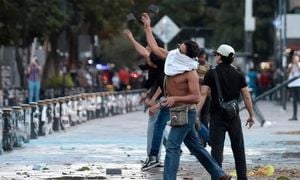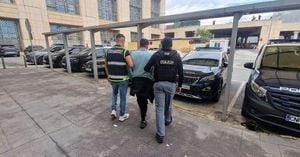On August 14, 2025, the usually tranquil plaza outside the Japanese American National Museum in downtown Los Angeles became the unlikely stage for a high-stakes political drama. As Governor Gavin Newsom prepared to announce a bold plan to counter President Trump’s controversial redistricting efforts, scores of masked, heavily armed federal immigration agents assembled outside—an image that startled attendees and drew swift condemnation from California’s Democratic leadership.
Inside, Newsom was flanked by the state’s most powerful Democrats, unveiling a special election campaign intended to redraw California’s congressional districts in a move widely seen as a direct response to Republican-led redistricting pushes. Yet, it was the spectacle outside that quickly stole the headlines: dozens of Border Patrol agents, led by Sector Chief Gregory Bovino, gathered in tactical gear, their presence both conspicuous and unexplained. The operation resulted in at least two arrests, including a man reportedly delivering strawberries who now faces deportation to Mexico.
Two weeks later, on August 26, a coalition of Southern California congressional Democrats fired off a pointed letter to Department of Homeland Security leaders, demanding answers about the deployment. The letter, spearheaded by Representative Laura Friedman of Glendale and signed by at least 13 Democratic lawmakers—including Senator Alex Padilla and Representatives Judy Chu, Gil Cisneros, Robert Garcia, Luz Rivas, Ted Lieu, Nanette Diaz Barragán, and Brad Sherman—sought clarity on who authorized the operation, whether the event’s political nature influenced the decision, and whether the size and composition of the force was justified.
“We just wanted to get some questions answered,” Friedman told the Los Angeles Times. “I was at Newsom’s press conference. It was really shocking to have as many as a hundred federal officers in tactical gear just appear.” The group demanded written responses by September 4, seeking details on the operational criteria used and whether Homeland Security had advance knowledge of the individuals arrested.
The timing of the enforcement action raised eyebrows. As Newsom outlined plans that could bolster his own 2028 presidential ambitions, the heavy federal presence outside was interpreted by some as an act of political intimidation. Representative Judy Chu did not mince words: “It was outrageous that Trump and his supporters called ICE on us as we were conducting our redistricting press conference. It was clearly an attempt to intimidate us and to send a political message that he would use his law enforcement capabilities to make us feel afraid.”
This incident is just the latest flashpoint in a broader national debate over immigration enforcement and the role of federal agencies at politically charged events. That same week, more than a thousand miles east, a different kind of immigration showdown was unfolding in New Mexico. There, about a dozen Republican lawmakers and one Democrat toured the Otero County ICE detention center—New Mexico’s largest, housing over 850 detainees.
The two-hour tour, arranged by Republican State Senator Crystal Brantley through her contacts at the Department of Homeland Security, coincided with a legislative committee meeting in Las Cruces. The visit followed a July announcement from Governor Michelle Lujan Grisham’s office that the state might consider legislation to ban ICE detention centers during an upcoming special session. The tour, which was not officially sanctioned by the legislative committee, was touted by Republicans as bipartisan, though only Representative Andrea Romero, a Democrat from Santa Fe, attended from across the aisle.
Republican lawmakers emerged from the tour with glowing reviews. “Today’s tour was eye-opening,” Brantley said in a statement. “My biggest takeaway is this: This facility provides good jobs in Otero County and ensures detainees are treated humanely – far better than any alternative I’ve seen. ICE will do their job no matter what. Our choice is simple: a clean, safe, and accountable facility here, or one where we have no say in how detained migrants are treated.”
They highlighted amenities such as recreation facilities, a law library, a kitchen that caters to dietary restrictions, dental and mental health care, and entertainment devices like PlayStation 4 and musical instruments. Otero County Attorney RB Nichols emphasized the economic stakes: closure of the facility would mean the loss of 300 jobs, decreased tax revenue, and could impact $20 million in outstanding municipal bonds tied to the center.
But Romero, the lone Democrat on the tour, painted a starkly different picture. She described the environment as “eerily quiet,” with detainees confined to their beds and appearing “absolutely in despair.” She noted that recreational equipment was locked away during the visit, and she questioned whether the facility’s presentation was merely a carefully staged show for lawmakers. “People are confined to their beds, not speaking. It was eerily quiet across the facility,” Romero told Source New Mexico. “I don’t know what the day-to-day really looks like. I don’t. But, certainly, a rosy picture painted, for sure.”
Romero also raised concerns about detainees’ rights, due process, and the speed at which some are deported without adequate legal representation. According to data cited during the tour, the majority of ICE detainees have no criminal history—an issue Romero pressed facility officials on repeatedly. “Being the only Democrat on the tour, I’m the only one asking questions about all of this,” she said. “It became very lonely, trying to understand what was going on, and being the only one asking questions about constitutional rights, due process, contracts, etc.”
The tour did not include direct interaction with detainees due to legal concerns, which further fueled skepticism among Democrats. Senator Antoinette Sedillo Lopez, who has long sought access to ICE facilities, argued that meaningful oversight requires private, candid conversations with those detained—something not possible on the orchestrated tour. “If you can’t talk in private with the residents and assure them that there won’t be any kind of repercussions for them for an honest conversation, then that is not an adequate tour,” she told Source New Mexico.
Meanwhile, the debate over transparency and oversight in immigration enforcement reached the federal level. On August 26, congressional Democrats pressed President Trump’s border czar Tom Homan to disclose his past financial ties to one of the nation’s largest immigrant detention contractors. The push came after The Washington Post reported on potential conflicts of interest involving Homan, highlighting ongoing concerns about the relationship between government officials overseeing immigration enforcement and private detention contractors.
As the nation barrels toward a November special election in California and possible legislative action in New Mexico, the questions swirling around immigration enforcement, political influence, and transparency show no sign of abating. Lawmakers in both states have called for greater oversight, more transparency, and answers from those in charge—demands that reflect a broader, unresolved tension at the heart of America’s immigration debate.
With deadlines looming for federal responses and further legislative hearings scheduled, the coming weeks promise to test the balance between security, civil rights, and political power in ways both visible and, perhaps, unseen.




